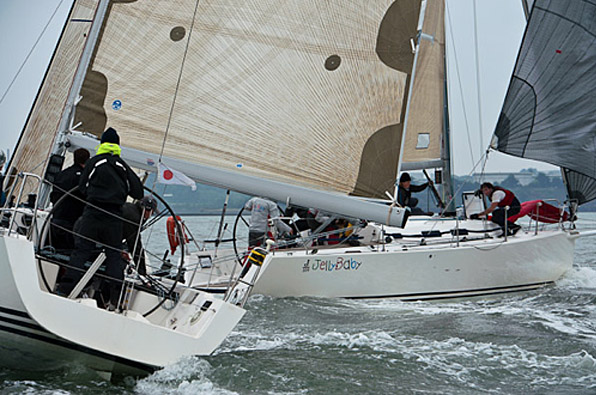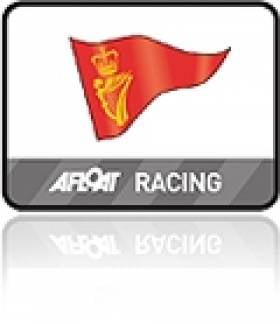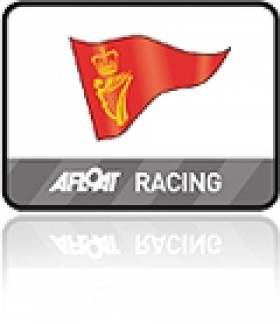Displaying items by tag: O'Flynn Exhams Autumn League
Weather Gods at Play for October League Finale
Arriving at the Royal Cork Yacht Club yesterday for the final day of the O'Flynn Exhams Autumn League there wasn't a puff of wind to be felt writes Claire Bateman. The Club Burgee hung limply and the general consensus of competitors on the marina was that there wouldn't be any wind. However, lo and behold as the boats went out into the harbour wind was blowing from the south and spirits (not the Halloween Spooks) lifted immediately. PHOTO GALLERY HERE.
Race Officer David O'Brien in Admiral Paddy McGlade's Sabrone anchored off Whitegate and set a course a course for the Red Fleet out to the mouth of the harbour starting Class Two first and this was great as they were followed by the 1720s and in turn by the higher rated boats of Classes Zero and 1. This made for a great intermingling of the fleets in the harbour. Starting just after the top of the tide and with a southerly breeze this was a help to the boats on the beat as they tacked to and frow some favouring the western shore but the majority favouring the eastern shore. Conditions got a bit lumpy with the wind over tide and steeped up by a ground swell. There were a couple of showers but considering the summer like conditions that had been enjoyed for the series nobody was going to bother about this. After each shower cleared there was the most amazing light on the fleets and rainbows added more punch to the colour of the spinnakers.
In race 2 there was an incident on the line in Class 1 when there was a coming together of Mary O'Keeffe's Tux and Wan and Eric Waterman's Saxon Senator resulting in Senator's retiral. Also in the Red Fleet there were six boats disqualified for sailing the wrong way through the finish line – perhaps more reading of the Sailing Instructions required!!
Race Officer Richard Leonard in Pascal Healy's Capta Ventum anchored off Cuskinny to sail the Green Fleet on the laid courses. Richard, perfectionist that he is, complained bitterly that the wind had shifted some 20 degrees after the start and when sailing multi fleets particularly on a short course it would be extremely difficult to shift the marks. Nevertheless he got in two good races.
In Class 3 there was very keen competition between Ian Travers in Bandit and the Kenefick O'Brien favourite Tiger and they shared a first and second each on the day. However, Tiger triumphed overall by a winning margin of 2 points after 10 races. Newcomer to racing Fergus Coughlan in Whyte Knight had two wins on the day in Class 3 ECHO ensuring his overall andpopular win in this class.
IN Class 4 ECHO Michael Murphy in Shelly D created his own bit of sailing history when sailed his boat to victory in this class. He had sailed Shelly D in the October League for 31 consecutive years and received a a tremendous ovation for his efforts. However, in Class 4 IRC there was no stopping Alan Mulcahy in Sundancer from taking the overall prize with 7 wins and 2 seconds.
In White Sail 1 IRC Tom and Conor McNeice in Minx 111 had two thirds yesterday and this was enough to give them the overall win in the class. The Carroll Bros. In Chancer had two wins yesterday but ended up seond overall.
In White Sail 2 IRC Clive Doherty's Phaeton made a late challenge winning both races and this was enough for overall victory over Roy Hanan's Plumbat.
The prizegiving took place in a packed dining room after a very enjoyable meal. The prizes were magnificent, and were presented by Richard Neville, Managing Partner from the excellent sponsor O'Flynn Exhams Solicitors, aided by Admiral Paddy McGlade and Regatta Director, Rear Admiral Ronan Enright. Irene O'Donovan also a partner from the sponsor company, was present with her husband Pascal Healy who had provided the committee boat for the laid course and who were both on board for the series.
A most successful series was enjoyed by all and sundry and not forgotten in the acknowledgements were the club volunteers who had given freely of their time and effort to make the event the memorable Autumn League that it was.
Crotty Stays on Top in 1720s
The sun may have been missing from the scene this morning at Crosshaven and the skies may have been dark and overcast but the wind was blowing, the buzz was very definitly in the the air and the spring was in every sailors'step as they arrived in their droves to set forth on the second day of the O'Flynn Exhams Autumn League at the Royal Cork Yacht Club writes Claire Bateman. Photos from race two on the gallery click HERE
The wind was gusting some 26 knots on the marina but by the time the boats had reached the comittee boats for the start of racing the east wind had moderated to some 10/12 knots and later went north easterly, was obviously going to provide a good day of sailing. The two Race Officers had put their minds together on the courses and decided to sail both fleets within the harbour and this proved to be an outstanding success. Race Officer David O'Brien was today on Classes Three, Four and Whitesail one and two and his boat "Sabrone" was kindly provided by Admiral Paddy McGlade who was on board for the racing. Richard Leonard's committee boat "Capta Ventum" was kindly provided by Pat Healy who was also on board to watch the day's events unfold.

Tight handling in the second day of Cork's Autumn League races. Photo: Bob Bateman. More on the gallery HERE
There are exceptionally high spring tides at the moment and this exercised the minds of the all sailors to keep out of the strong tide and on the other hand to avoid going aground on any of the banks around the harbour. In this regard the one casualty was Peter Webster's Thistle from Class Four which went aground and spent some time waiting for the incoming tide.
The tight courses and the racing tide coupled with the sufficient breeze made for close racing. John Crotty was a very happy man sailing the 1720 Two 2 Tango and winning the class for the second week in a row. Class One is of course a very competitive class and there was close racing between the 4 X332s. In Class Two it was good to see Bad Company and wicked so close together but the day in Class Two belonged to Shane Statham of Waterford Harbour in Slack Alice who ended first overall in IRC and ECHO. In Whitesail 2 Clive Doherty had an excellent day winning IRC1 and Ernie Dillon received a tumultous reception when his name was called out in the same class for wining ECHO.
The combination of the fleets racing in the magnificent harbour today added greatly to the buzz with yachts flying everywhere and the fleets moving around with the greatest of ease. Some were up off Cobh while others went to a laid mark off the Aghada shore and Whitesaill one and two were given a course which should have taken in the OFE2 buoy outside the harbour but given the fear would lighten even further race officer David O'Brien decided to shorten the course so the white sail fleets hada somewhat easy day of sailing and returned early to the warmth of the club house. It was certainly a huge success on the part of the race officers and added greatly to the enjoyment as was heard from the sailors in their apés sail get totether. There were three protests from the racing today but one was withdrawn and the other two were resolved amicably so all was well and the prize giving presided over by Aeibhín Cahalan of O'Flynn Exhams brought a fitting finish to the day.

























































